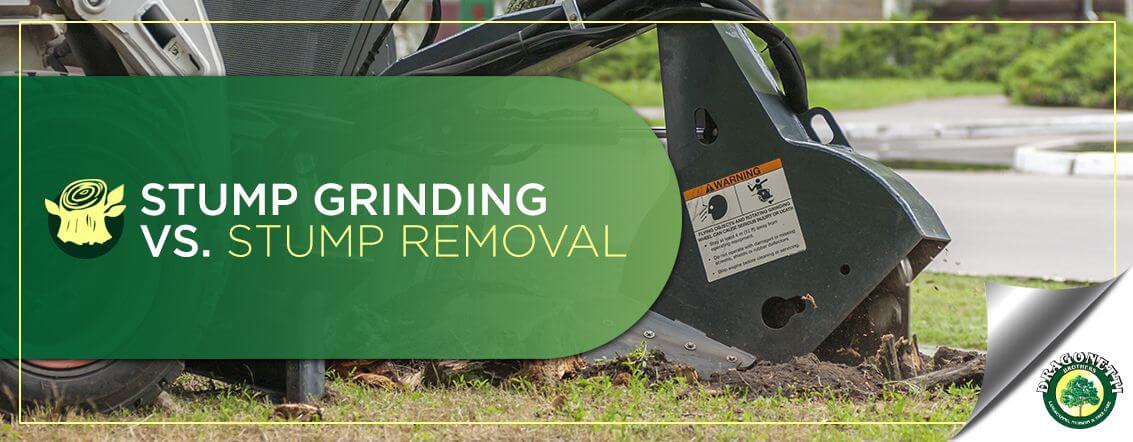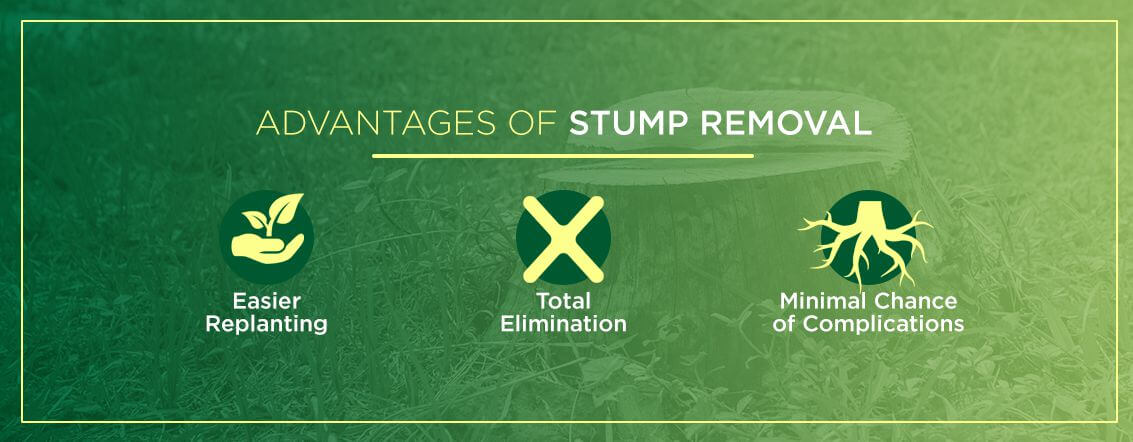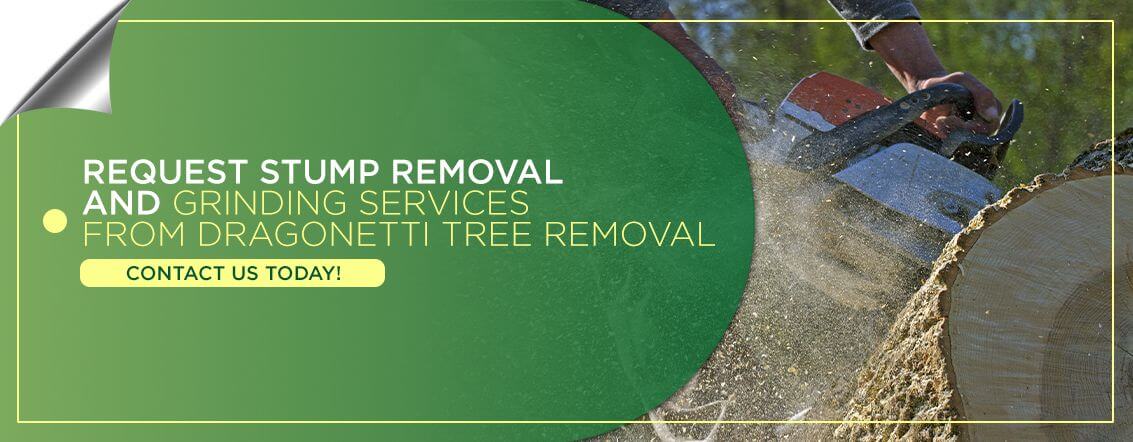
When a tree on your property has fallen or undergone removal services, you’ll need to figure out what to do with the stump. You could leave it in your yard, but leaving the stump presents a few disadvantages. The stump may become a tripping and falling hazard, especially for children, or it may prevent you from replanting or landscaping the way you’d like. There’s also the risk that the stump will rot and look unsightly.
When you’re thinking about how to get rid of stumps, you’ll usually choose either stump grinding or total stump removal. Each of these stump removal techniques has particular advantages and disadvantages. In the guide below, we’ll explain more about how to remove a stump from the ground and discuss the pros and cons of stump removal and grinding in further detail.
ADVANTAGES OF STUMP GRINDING
What is tree stump grinding? Tree stump grinding uses special ground saws to shred a stump into wood chips or sawdust. The machine can grind the stump to ground level, or it can grind the stump as low as 12 inches below ground level to create a hole you can fill with dirt.
Grinding a stump is one of the best ways to remove a stump for several reasons. Here are some of the advantages of removing a stump by grinding it:
1. SPEED
Grinding a stump is quick and efficient. It often takes only half an hour to two hours — typically a faster solution than removing the stump entirely. Grinding equipment works fast, and when it’s finished, there’s not much left to do. Grinding does leave you with a pile of chips or sawdust — which, though they require some time for a quick cleanup, are well worth the effort because you can use them for other purposes around your home and yard.
2. MINIMAL FILLING
When you pull a stump out of the ground, you need to fill in the giant hole left where the roots were. Filling in the hole can be time-consuming, and hard labor. But when you grind a stump, the roots remain in place, so there’s either no hole or a small hole to fill in afterward, depending on how far down you grind. Many people are happy to find themselves relieved of doing or paying for this extra work.
3. COST
Grinding a stump is usually cheaper than removing it. The reason is that complete removal is a much more labor-intensive and time-consuming process and requires heavy-duty machines with greater power demands. Many people would rather go with the more economical option and use the savings for other landscaping projects, savings or fun treats. So grinding is probably the best stump removal method for the money.
DISADVANTAGES OF STUMP GRINDING
However, grinding a stump also comes with a few drawbacks. Here are some of the disadvantages of stump grinding:
1. MESS
Stump grinding leaves a mess that requires cleanup. The small bits of wood go everywhere, and it can take some time to get your property looking neat again. Since complete stump removal either keeps the stump intact or dissolves it chemically, there’s no chip mess to clean up afterward. However, complete stump removal can be messy in a different way, usually leaving a gaping hole and clods of earth strewn around your yard. You’ll need to consider these tradeoffs as you decide between the two techniques.
2. POTENTIAL SPROUTING
When you leave the roots in the ground, there’s always the possibility of sprouting. The roots may send up small new shoots at some distance from where the stump used to be. Some homeowners and business owners may welcome this new life, but if you’re not interested in having new trees in that area, dealing with the fresh sprouts can be a nuisance.
3. ROOT DECAY
After stump grinding, the tree roots will decay. Decay is a natural part of trees’ life cycle, and the roots often break down over many years, nourishing the local ecosystem as they do so. However, some homeowners and business owners may not want decaying matter and the associated fungi, bugs and microorganisms in their yards.
ADVANTAGES OF STUMP REMOVAL

Complete stump removal can also be an excellent option for getting rid of unsightly or inconvenient stumps. It typically involves pulling the whole stump out of the earth with a winch, hydraulic jack or tractor, though it sometimes uses chemicals or burning methods. Here are a few of the advantages of complete stump removal:
1. EASIER REPLANTING
Removing a stump entirely gives you the ability to plant a new tree. The roots aren’t there taking up space, and you’ve likely filled in the hole with rich, clean soil that’s ideal for growth. If you’re interested in planting a new tree in the same spot as the old one — particularly if the old tree had sentimental value — complete removal offers an ideal solution.
2. TOTAL ELIMINATION
Complete elimination of the stump opens up many more possibilities for your yard. Even if you grind the stump down several inches below the surface, the roots are still there and may cause issues with planting or installing yard fixtures. Complete removal solves this problem.
3. MINIMAL CHANCE OF COMPLICATIONS
When you remove a stump, you remove the risk that it will sprout or rot. Because grinding down the stump still leaves the roots below the soil, they could cause difficulties in the future, but total removal eliminates that concern.
DISADVANTAGES OF STUMP REMOVAL
However, like stump grinding, stump removal also has a few drawbacks. Here are some of the disadvantages of complete stump removal:
1. DURATION
Pulling a stump out of the ground takes more time than merely grinding it down, and dissolving a stump with chemicals is also time-consuming. If you want to get the work done as quickly as possible, total stump removal may not be the right option.
2. GREATER INVESTMENT
Overall, removing a stump involves more of an investment of resources and energy than grinding does. Taking up much more time is part of it, but it’s also much more strenuous and costly since the roots of a tree often represent more than a third of the tree’s total biomass. Even a half-inch root can require 450 pounds of force to pull from the soil, and an extensive root system can demand much more. To minimize the overall impact of stump removal, you’ll probably want to look into an option like grinding instead.
3. EXTRA WORK
Once you’ve had your stump ground down past the surface of the soil, you’re done — except for a little filling-in and chip cleanup. But total stump removal involves more concentrated extra work, such as filling in the hole left in the ground and hauling the massive, cumbersome stump away or cleaning up abrasive chemicals. If you’d rather minimize the work involved, stump grinding services are likely to be more appealing.
REQUEST STUMP REMOVAL AND GRINDING SERVICES FROM DRAGONETTI TREE REMOVAL

To see the benefits of removal and grinding services for the stumps on your property, contact Dragonetti Tree Removal. We are a family-owned business, fully licensed and insured for tree services, and we pride ourselves on making our customers our top priority. Our team of professional, hardworking experts is happy to take on any size job, no matter how big or small. The combination of our industry expertise and commitment to excellent work means we’ll get the job done right, leaving you with a smooth, beautiful yard that’s ready for new projects or growth.
